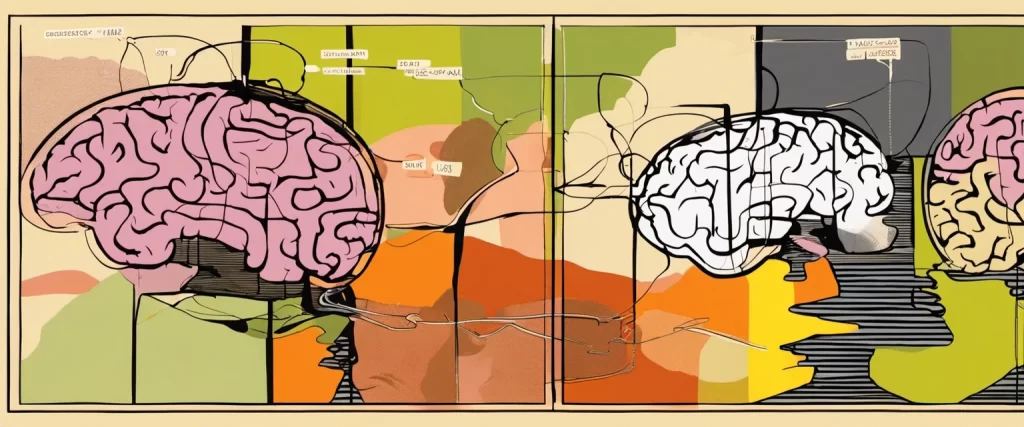—Thinking, Fast and Slow & Influence
In the realm of social psychology and behavioral economics, two prominent figures stand at the forefront as pioneers in shedding light on the intricate workings of the human mind and its underlying biases. Daniel Kahneman, Nobel laureate and renowned psychologist, and Robert B. Cialdini, acclaimed social psychologist, have each graced the realm of literature with their groundbreaking works that have captivated and enlightened readers across the globe.
In this comparative study, we delve into the depths of two seminal books authored by these exceptional thinkers: “Thinking, Fast and Slow” by Daniel Kahneman and “Influence” by Robert B. Cialdini. While seemingly different in their subject matter, these books share a common thread in their exploration of the subconscious forces that shape our decision-making processes and influence our behavior.
Daniel Kahneman‘s “Thinking, Fast and Slow” serves as a profound exploration into the intricacies of our dual cognitive systems. Drawing from decades of research, Kahneman introduces readers to the dichotomy between our intuitive, fast-thinking system and our more deliberate, slower-thinking system. Through a captivating narrative intertwined with illuminating anecdotes and scientific studies, Kahneman guides us on a journey through a myriad of cognitive biases that hinder our rationality, shattering preconceived notions of human decision-making.
On the other hand, Robert B. Cialdini’s “Influence: The Psychology of Persuasion” delves into the art and science of influence and persuasion. By uncovering the six universal principles that influence our compliance with requests, Cialdini unveils the potency of social psychology in shaping our everyday choices. With a combination of real-life examples, experiments, and psychological principles, Cialdini showcases how individuals and organizations leverage these principles to compel us into actions we may not have otherwise taken.
Although distinct in their focus, these two works converge in their aim to unravel the mysteries of the human mind and unveil the subtle ways in which our thoughts and decisions are formed. By examining the concepts of cognitive biases in decision-making and the psychological methods of persuasion, we can gain a comprehensive understanding of the intricacies of our thought processes and the factors that influence our behavior.
Through this comparative study, we seek to explore the complementarity between these two seminal works and the insights they offer into our intricate psychological framework. By juxtaposing the pioneering ideas of Daniel Kahneman and Robert B. Cialdini, we uncover a rich tapestry of knowledge that sheds light on the depths of human cognition and the underlying forces that drive our actions.
Brief Summary of Two Books
Thinking, Fast and Slow by Daniel Kahneman
“Thinking, Fast and Slow” by Daniel Kahneman is a landmark book that explores the two systems that drive our thinking processes. The author, a Nobel laureate in economics, presents a comprehensive understanding of the cognitive biases and errors that affect our decision-making abilities. System 1, the intuitive and automatic mode, operates quickly and effortlessly, often relying on instinct. Conversely, System 2, the deliberate and conscious mode, involves logical thinking and requires effort. Throughout the book, Kahneman delves into numerous examples and experiments, drawing on his research in behavioral economics and psychology to highlight how these two systems work together, shaping our judgments and choices. He dissects topics such as the illusion of expertise, confirmation bias, overconfidence, and the impact of emotion on decision making. Ultimately, “Thinking, Fast and Slow” serves as a comprehensive guide to understanding the complexities of our minds and provides actionable insights for improving our decision-making processes.
Influence: The Psychology of Persuasion by Robert B
Influence: The Psychology of Persuasion by Robert B. Cialdini explores the various techniques and principles behind the process of persuasion. By analyzing the psychological factors that contribute to influence, Cialdini provides readers with valuable insights into how people can be persuaded and how to resist being manipulated by others. The book delves into six key principles of influence, including reciprocity, scarcity, authority, consistency, liking, and social proof. Cialdini illustrates these principles through real-life examples and studies, offering readers a comprehensive understanding of the psychological tactics used by advertisers, salespeople, and others seeking to influence behavior. This book serves as a guide for individuals seeking to become more aware of these techniques and how to use them ethically, as well as for those seeking to avoid being manipulated by them.
Comparison between Two Books

Similarities in persuasion
In both “Thinking, Fast and Slow” by Daniel Kahneman and “Influence: The Psychology of Persuasion” by Robert B. Cialdini, the authors explore the concept of persuasion and shed light on various similarities:
1. Central role of cognitive biases: Both books delve into the influence of cognitive biases on the decision-making process. Kahneman discusses the two systems of thinking – the fast, intuitive System 1 and the slow, deliberate System 2 – showing how biases can distort our judgments. Similarly, Cialdini highlights several biases like social proof, authority, and scarcity that shape our behavior and make us more susceptible to persuasion.
2. Power of key principles: Both books emphasize certain principles that significantly impact persuasion. Kahneman focuses on concepts like framing, anchoring, and availability heuristic, explaining how they affect decision-making. Cialdini outlines six principles of influence, including reciprocity, commitment and consistency, and liking, demonstrating how they can be used to persuade others effectively.
3. Role of social context: Both authors acknowledge the significance of social context in the persuasion process. Kahneman delves into the role of social norms and the impact of peer pressure on decision-making. Cialdini also highlights the power of social proof and how it affects our behavior when we observe others in similar situations.
4. Psychological factors influencing persuasion: Both books delve into various psychological factors that play a role in persuasion. Kahneman explores concepts such as loss aversion and prospect theory, explaining how they shape decision-making. Cialdini discusses the role of emotions, trust, and authority in influencing individuals’ choices.
5. Influence of heuristics: Both authors explore how heuristics, or mental shortcuts, can be utilized to persuade individuals. Kahneman describes various heuristics, such as the availability heuristic and representativeness heuristic, and how they impact judgment. Cialdini explores how heuristics like the liking principle and the scarcity principle can be harnessed to increase persuasiveness.
6. Ethical considerations: Both books address the ethical implications of persuasion. Kahneman highlights the importance of understanding biases and their potential for manipulation. Cialdini also discusses how individuals can guard against unwarranted persuasion and make more informed decisions.
In summary, “Thinking, Fast and Slow” and “Influence: The Psychology of Persuasion” share similarities in their exploration of cognitive biases, key principles of persuasion, the role of social context, psychological factors influencing persuasion, the influence of heuristics, and ethical considerations surrounding persuasion. These books provide valuable insights into the complexities of persuasion and enhance our understanding of how individuals can be influenced.
Divergences in persuasion
Thinking, Fast and Slow by Daniel Kahneman and Influence: The Psychology of Persuasion by Robert B have several similarities but also diverge on certain aspects of persuasion.
1. Perspective on Persuasion:
– Thinking, Fast and Slow focuses on the different systems of thinking that humans employ, namely the intuitive and deliberate systems. While persuasion is discussed within the context of cognitive biases and heuristics, the book primarily explores how these biases affect our decision-making processes.
– Influence: The Psychology of Persuasion, on the other hand, specifically centers around the tactics and techniques used by individuals to influence others. Robert B outlines six key principles of persuasion – reciprocity, commitment and consistency, social proof, liking, authority, and scarcity – and delves into real-life examples to illustrate how they are commonly employed.
2. Depth of Analysis:
– Thinking, Fast and Slow provides a much deeper dive into the inner workings of human cognition and decision-making. Daniel Kahneman draws from decades of research to uncover the cognitive biases that often lead to irrational judgments and choices. While persuasion is one of the aspects investigated, it is not the central focus of the book.
– Influence: The Psychology of Persuasion, as the title suggests, places a heavy emphasis on persuasion techniques. Robert B examines each principle of persuasion in detail, elaborating on the underlying psychological mechanisms that make them effective. This book offers a more comprehensive analysis of how persuasion works and how individuals can guard against manipulative tactics.
3. Application of Research:
– Thinking, Fast and Slow presents academic research and experiments conducted by Daniel Kahneman and his colleagues, providing a rigorous scientific foundation to support the theories presented. However, the practical applications of these findings are not extensively explored.
– Influence: The Psychology of Persuasion places a greater emphasis on the practical application of persuasion techniques. Robert B provides numerous real-life examples, anecdotes, and case studies to illustrate how these principles are utilized by marketers, salespeople, and individuals in daily interactions. The book focuses on the implementation of persuasive strategies in various contexts.
In summary, while both Thinking, Fast and Slow and Influence: The Psychology of Persuasion touch upon the topic of persuasion, their divergences lie in the scope, depth of analysis, and practical application. Daniel Kahneman’s book primarily explores cognitive biases and decision-making, whereas Robert B’s work delves into the principles of persuasion and their real-life applications.

Conclusion
Both “Thinking, Fast and Slow” by Daniel Kahneman and “Influence: The Psychology of Persuasion” by Robert B. Cialdini are highly acclaimed books in the field of psychology and decision-making. The choice between the two depends on your personal interests and what specifically you are looking to gain from reading.
– “Thinking, Fast and Slow” delves into the cognitive biases and heuristics that affect human decision-making. It explores the two systems of thinking – the intuitive, fast-thinking system, and the deliberate, slow-thinking system. This book provides deep insights into how our minds work and how we can improve our decision-making abilities. It is a highly recommended read for those interested in understanding human behavior and the processes behind decision-making.
– “Influence: The Psychology of Persuasion” focuses on the principles of persuasion and how they are employed to influence others. Cialdini discusses six principles – reciprocity, commitment and consistency, social proof, authority, liking, and scarcity – and provides real-life examples and studies to illustrate their effectiveness. This book is beneficial for those interested in understanding the psychology behind persuasion and how to defend against manipulative tactics.
Both books have their own unique value, and it ultimately comes down to your personal interests. If you want to gain a deeper understanding of cognitive biases and decision-making processes, “Thinking, Fast and Slow” is a great choice. If you are more interested in the principles of persuasion and how they can be applied, “Influence: The Psychology of Persuasion” would be the better option.



